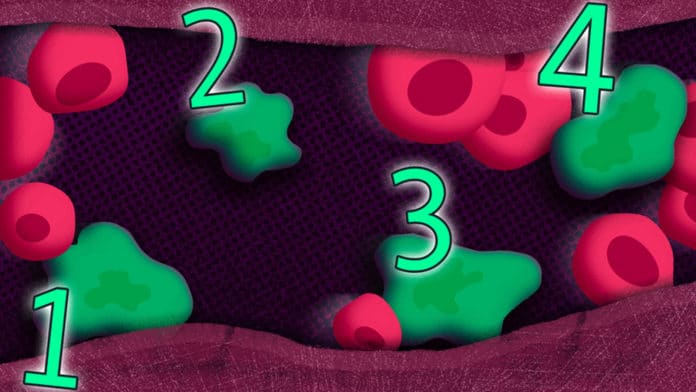Using a newly developed technique, MIT scientists could measure the generation rate of these circulating tumor cells (CTCs) in mice. This approach allowed scientists to see how long CTCs survive once released into the bloodstream.
The technique could help scientists determine how different types of cancers spread through the body.
Scientists studied CTCs from pancreatic tumors as well as two types of lung tumors.
Several strategies have been developed to capture these elusive cells in recent years, revealing important information about a patient’s tumor. Moreover, it can help doctors track how a tumor is responding to treatment.
Finding CTCs in mice is quite difficult as they are just more than 1 milliliter of blood.
Scott Manalis, the David H. Koch Professor of Engineering in the departments of Biological Engineering and Mechanical Engineering, said, “Being able to study CTCs in mice could help researchers answer many outstanding questions about how rapidly tumors shed these cells, how long they survive in circulation, and how efficiently they seed new tumors.”
To answer some of these questions, scientists designed a system that allows them to remove blood from a mouse with a tumor and flow it into a healthy mouse. Through a separate tube, blood from the healthy mouse flows back to the tumor-bearing mouse. The system includes two cell counters (one for each mouse) that detect and remove circulating tumor cells from the blood.
Using this setup, scientists observed all of the blood from each mouse in less than an hour. They also determined the concentration of CTCs in the bloodstream of the tumor-bearing mouse and the healthy mouse. Based on that, they estimated the rate at which CTCs are generated in the tumor-bearing mouse.
The system also allows them to calculate the half-life of the cells.
Scientists tested their system on mice with three different types of tumors: pancreatic cancer, small cell lung cancer, and non-small cell lung cancer.
They found that the half-life of CTCs was fairly similar between the three types of tumors, with values ranging from 40 seconds to about 250 seconds. However, the generation rates showed much more variability between different tumor types.
Small cell lung tumors, which are known to be aggressively metastatic, could shed more than 100,000 CTCs per hour, while non-small cell lung tumors and pancreatic tumors shed as few as 60 CTCs per hour.
The results also demonstrate that the endogenous CTCs persist much longer than that.
Scientists also learned that the healthy mice that received CTCs later developed metastases, even after exchanging a few thousand CTCs. They found that CTCs from small-cell lung tumors formed metastases in the livers of the recipient healthy mice, just as they did in the mice where the tumors originally formed.
Bashar Hamza Ph.D. ’20 said, “What we realized was that these CTCs that we’re injecting into the healthy recipient mouse start to grow and create metastases that we can detect after a couple of months. That was exciting to observe because it validated that our blood-exchange technique can also be used to gently inject a viable CTC sample in its native blood environment without having to enrich it using harsh in vitro techniques.”
Graduate student Alex Miller said, “Using this approach, researchers now hope to study how different drug treatments influence CTC levels. With this system, we can look at the real-time concentration of CTCs, so we can perform a drug treatment and look at how it is affecting half-life time and generation rate.”
In the future, scientists are planning to study other types of cancers, including blood cancers such as leukemias and lymphomas.
Journal Reference:
- Hamza, B., Miller, A.B., Meier, L. et al. Measuring kinetics and the metastatic propensity of CTCs by blood exchange between mice. Nat Commun 12, 5680 (2021). DOI: 10.1038/s41467-021-25917-5
